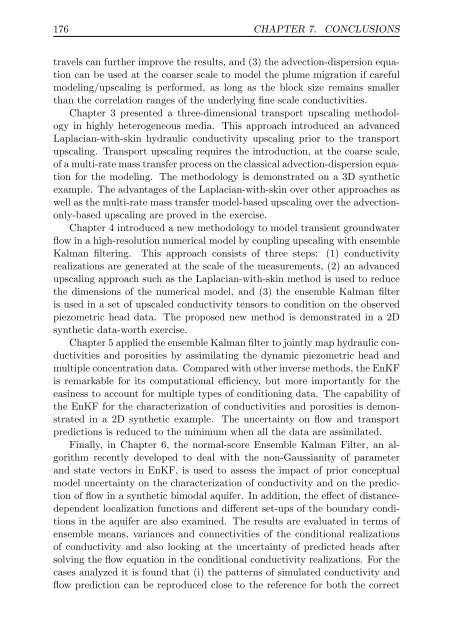Upscaling and Inverse Modeling of Groundwater Flow and Mass ...
Upscaling and Inverse Modeling of Groundwater Flow and Mass ...
Upscaling and Inverse Modeling of Groundwater Flow and Mass ...
You also want an ePaper? Increase the reach of your titles
YUMPU automatically turns print PDFs into web optimized ePapers that Google loves.
176 CHAPTER 7. CONCLUSIONS<br />
travels can further improve the results, <strong>and</strong> (3) the advection-dispersion equation<br />
can be used at the coarser scale to model the plume migration if careful<br />
modeling/upscaling is performed, as long as the block size remains smaller<br />
than the correlation ranges <strong>of</strong> the underlying fine scale conductivities.<br />
Chapter 3 presented a three-dimensional transport upscaling methodology<br />
in highly heterogeneous media. This approach introduced an advanced<br />
Laplacian-with-skin hydraulic conductivity upscaling prior to the transport<br />
upscaling. Transport upscaling requires the introduction, at the coarse scale,<br />
<strong>of</strong> a multi-rate mass transfer process on the classical advection-dispersion equation<br />
for the modeling. The methodology is demonstrated on a 3D synthetic<br />
example. The advantages <strong>of</strong> the Laplacian-with-skin over other approaches as<br />
well as the multi-rate mass transfer model-based upscaling over the advectiononly-based<br />
upscaling are proved in the exercise.<br />
Chapter 4 introduced a new methodology to model transient groundwater<br />
flow in a high-resolution numerical model by coupling upscaling with ensemble<br />
Kalman filtering. This approach consists <strong>of</strong> three steps: (1) conductivity<br />
realizations are generated at the scale <strong>of</strong> the measurements, (2) an advanced<br />
upscaling approach such as the Laplacian-with-skin method is used to reduce<br />
the dimensions <strong>of</strong> the numerical model, <strong>and</strong> (3) the ensemble Kalman filter<br />
is used in a set <strong>of</strong> upscaled conductivity tensors to condition on the observed<br />
piezometric head data. The proposed new method is demonstrated in a 2D<br />
synthetic data-worth exercise.<br />
Chapter 5 applied the ensemble Kalman filter to jointly map hydraulic conductivities<br />
<strong>and</strong> porosities by assimilating the dynamic piezometric head <strong>and</strong><br />
multiple concentration data. Compared with other inverse methods, the EnKF<br />
is remarkable for its computational efficiency, but more importantly for the<br />
easiness to account for multiple types <strong>of</strong> conditioning data. The capability <strong>of</strong><br />
the EnKF for the characterization <strong>of</strong> conductivities <strong>and</strong> porosities is demonstrated<br />
in a 2D synthetic example. The uncertainty on flow <strong>and</strong> transport<br />
predictions is reduced to the minimum when all the data are assimilated.<br />
Finally, in Chapter 6, the normal-score Ensemble Kalman Filter, an algorithm<br />
recently developed to deal with the non-Gaussianity <strong>of</strong> parameter<br />
<strong>and</strong> state vectors in EnKF, is used to assess the impact <strong>of</strong> prior conceptual<br />
model uncertainty on the characterization <strong>of</strong> conductivity <strong>and</strong> on the prediction<br />
<strong>of</strong> flow in a synthetic bimodal aquifer. In addition, the effect <strong>of</strong> distancedependent<br />
localization functions <strong>and</strong> different set-ups <strong>of</strong> the boundary conditions<br />
in the aquifer are also examined. The results are evaluated in terms <strong>of</strong><br />
ensemble means, variances <strong>and</strong> connectivities <strong>of</strong> the conditional realizations<br />
<strong>of</strong> conductivity <strong>and</strong> also looking at the uncertainty <strong>of</strong> predicted heads after<br />
solving the flow equation in the conditional conductivity realizations. For the<br />
cases analyzed it is found that (i) the patterns <strong>of</strong> simulated conductivity <strong>and</strong><br />
flow prediction can be reproduced close to the reference for both the correct


